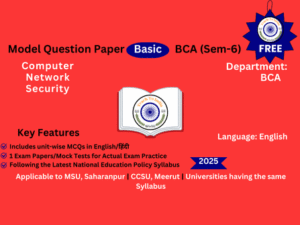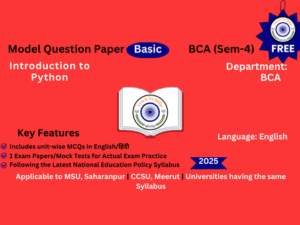कॉर्डेट्स की विविधता और तुलनात्मक शरीर रचना (सेमेस्टर -5)
- Description
- Curriculum
- Reviews

Teach To India प्रकाशन
कॉर्डेट्स की विविधता और तुलनात्मक शरीर रचना
-
यह मॉडल पेपर यह सुनिश्चित करता है कि सभी संभावित प्रश्न जो परीक्षा में आ सकते हैं, वे यूनिट में पूरी तरह से शामिल हैं, चाहे वे सीधे हों या अप्रत्यक्ष रूप से।
-
इसे अनुभवी प्रोफेसरों द्वारा बहुत सावधानी से तैयार किया गया है, जिन्हें परीक्षा मॉडल पेपर बनाने का व्यापक अनुभव है।
-
इस पेपर में विश्वविद्यालय द्वारा निर्धारित पाठ्यक्रम के आधार पर सभी मुख्य प्रश्न शामिल हैं।
-
400 से अधिक प्रश्न और उत्तरों के साथ, यह मॉडल पेपर विषय का पूरा पाठ्यक्रम कवर करता है।
-
प्रत्येक यूनिट में दीर्घ उत्तरीय ,लघु उत्तरीय और अति लघु उत्तरीय वाले प्रश्न शामिल हैं ताकि छात्रों को गहन समझ प्राप्त हो सके।
-
हमारे प्रश्न इस तरह तैयार किए गए हैं कि प्रत्येक यूनिट को कम से कम और अच्छी तरह चुने हुए प्रश्नों से कवर किया जा सके।
-
अनिवार्य आंतरिक परीक्षा के लिए हम 200 एक पंक्ति के प्रश्न-उत्तर प्रदान कर रहे हैं, जो प्रत्येक यूनिट को समान रूप से कवर करते हैं।
-
इस मॉडल पेपर में मॉक प्रश्नपत्र / पिछले साल के प्रश्नपत्र भी हल के साथ दिए गए हैं, जिससे छात्रों को परीक्षा के प्रश्नों की गहराई और विस्तार को समझने में मदद मिलती है।
|
Programme /Class: Degree |
Year: Third |
Semester: Fifth |
||
|
Co-Curricular Course |
||||
|
Course Title: Diversity of Chordates and Comparative Anatomy |
||||
|
Course outcomes: The student at the completion of the course will be able to: ● Demonstrate comprehensive identification abilities of chordate diversity ● Explain structural and functional diversity of chordates ● Explain evolutionary relationship amongst chordates ● Take up research in biological sciences.
|
||||
|
Credits: 4 |
Core Compulsory / Elective |
|||
|
Max. Marks: 25+75 |
Min. Passing Marks: 8+25 |
|||
|
Unit |
Topics |
|||
|
I |
Origin of Chordates & Hemichordata- Salient features and outline classification included ● Origin of Chordates. Classification of Phylum Chordata upto the class. ● Hemichordata: General characteristics, classification and detailed study of Balanoglossus(Habit and Habitat, Morphology, Anatomy, Physiology and Development).
|
|||
|
II |
Cephalochordata and Urochordata–Salient features and outline classification included ● (ii)Urochordata : General characteristics, classification and detailed study of Herdmania(Habit and Habitat, Morphology, Anatomy, Physiology and Post Embryonic Development ● Cephalochordata : General characteristics, classification and detailed study of Branchiostoma (Amphioxus) (Habit and Habitat, Morphology, Anatomy, Physiology).
|
|||
|
III |
Classification and General Characteristics of Vertebrates ● General characters and Classification of different classes of vertebrates (Pisces, Amphibia, Reptilia, Aves, Mammalia) up to the order with examples. ● Poisonous and Non Poisonous Snakes and biting mechanism. ● Neoteny and Paedogenesis ● Migration in birds
|
|||
|
IV |
Comparative Anatomy and Physiology of Vertebrates Integumentary System Structure, functions and derivatives of integument Skeletal System Overview of axial and appendicular skeleton, Jaw suspensorium, Visceral arches
|
|||
|
V |
Digestive System Alimentary canal and associated glands, dentition
|
|||
|
VI |
Respiratory System Skin, gills, lungs and air sacs; Accessory respiratory organs
|
|||
|
VII |
Circulatory System General plan of circulation, evolution of heart and aortic arches Urinogenital System Succession of kidney, Evolution of urinogenital ducts, Types of mammalian uteri
|
|||
|
VIII |
Nervous System Comparative account of brain, structure and evolution of brain in vertyebrates Autonomic nervous system, Spinal cord, Cranial nerves in mammals
Sense Organs Classification of receptors Brief account of visual and auditory receptors in man
|
|||
-
1यूनिट-1: अकशेरुकी की विविधता और आर्थिक जन्तुविज्ञान
-
2यूनिट-2: अकशेरुकी की विविधता और आर्थिक जन्तुविज्ञान
-
3यूनिट-3: अकशेरुकी की विविधता और आर्थिक जन्तुविज्ञान
-
4यूनिट-4: अकशेरुकी की विविधता और आर्थिक जन्तुविज्ञान
-
5यूनिट-5: अकशेरुकी की विविधता और आर्थिक जन्तुविज्ञान
-
6यूनिट-6: अकशेरुकी की विविधता और आर्थिक जन्तुविज्ञान
-
7यूनिट-7: अकशेरुकी की विविधता और आर्थिक जन्तुविज्ञान
-
8यूनिट-8: अकशेरुकी की विविधता और आर्थिक जन्तुविज्ञान







